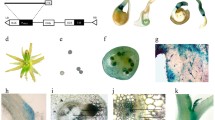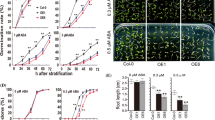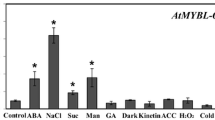Abstract
Key message
AtMYB2 protein represses the formation of axillary meristems in response to environmental stresses so that plants can undergo a shorter vegetative development stage under environmental stresses.
Abstract
Shoot branching is an important event determined by endogenous factors during the development of plants. The formation of axillary meristem is also significantly repressed by environmental stresses and the underlying mechanism is largely unknown. The REGULATOR OF AXILLARY MERISTEMS (RAX) genes encode the R2R3 MYB transcription factors that have been shown to regulate the formation of axillary meristems in Arabidopsis. The AtMYB2 is also a member of R2R3 MYB gene family whose expression is usually induced by the environmental stresses. In this study, our results showed that AtMYB2 protein plays a pivotal negative regulatory role in the formation of axillary meristem. AtMYB2 is mainly expressed in the leaf axils as that of RAX1. The environmental stresses can increase the expression of AtMYB2 protein which further inhibits the expression of RAX1 gene by binding to its promoter. Therefore, AtMYB2 protein represses the formation of axillary meristems in response to environmental stresses so that plants can undergo a shorter vegetative development stage under environmental stresses.








Similar content being viewed by others
References
Abe H, Yamaguchi-Shinozaki K, Urao T, Iwasaki T, Hosokawa D, Shinozaki K (1997) Role of arabidopsis MYC and MYB homologs in drought- and abscisic acid-regulated gene expression. Plant Cell 9:1859–1868
Baek D, Kim MC, Chun HJ, Kang S, Park HC, Shin G, Park J, Shen M, Hong H, Kim WY, Kim DH, Lee SY, Bressan RA, Bohnert HJ, Yun DJ (2013) Regulation of miR399f transcription by AtMYB2 affects phosphate starvation responses in Arabidopsis. Plant Physiol 161:362–373
Bartels D, Sunkar R (2005) Drought and salt tolerance in plants. Crit Rev Plant Sci 24:23–58
Claeys H, Inzé D (2013) The agony of choice: how plants balance growth and survival under water-limiting conditions. Plant Physiol 162:1768–1779
Clough SJ, Bent AF (1998) Floral dip: a simplified method for Agrobacterium-mediated transformation of Arabidopsis thaliana. Plant J 16:735–743
Collier S, Pendle A, Boudonck K, van Rij T, Dolan L, Shaw P (2006) A distant coilin homologue is required for the formation of Cajal bodies in Arabidopsis. Mol Biol Cell 17:2942–2951
Cui YC, Rao SF, Chang BB, Wang XS, Zhang KD, Hou XL, Zhu XY, Wu HJ, Tian ZX, Zhao Z, Yang CW, Huang T (2015) AtLa1 protein initiates IRES-dependent translation of WUSCHEL mRNA and regulates the stem cell homeostasis of Arabidopsis in response to environmental hazards. Plant Cell Environ 38:2098–2114
D'Odorico P, Davis KF, Rosa L, Carr JA, Chiarelli D, Dell’Angelo J, Gephart J, MacDonald GK, Seekell DA, Suweis S, Rulli MC (2018) The global food-energy-water nexus. Rev Geophys 56:456–531
Doust AN (2007) Grass architecture: genetic and environmental control of branching. Curr Opin Plant Biol 10:21–25
Fereres E, Orgaz F, Gonzalez-Dugo V (2011) Reflections on food security under water scarcity. J Exp Bot 62:4079–4086
Frederick JR, Camp CR, Bauer PJ (2001) Drought-stress effects on branch and mainstem seed yield and yield components of determinate soybean. Crop Sci 41:759–763
Greb T, Clarenz O, Schafer E, Muller D, Herrero R, Schmitz G, Theres K (2003) Molecular analysis of the LATERAL SUPPRESSOR gene in Arabidopsis reveals a conserved control mechanism for axillary meristem formation. Genes Dev 17:1175–1187
Guo YF, Gan SS (2011) AtMYB2 regulates whole plant senescence by inhibiting cytokinin-mediated branching at late stages of development in Arabidopsis. Plant Physiol 156:1612–1619
Ings J, Mur LA, Robson PR, Bosch M (2013) Physiological and growth responses to water deficit in the bioenergy crop Miscanthus × giganteus. Front Plant Sci 4:468
Jasinski S, Piazza P, Craft J, Hay A, Woolley L, Rieu I, Phillips A, Hedden P, Tsiantis M (2005) KNOX action in Arabidopsis is mediated by coordinate regulation of cytokinin and gibberellin activities. Curr Biol 15:1560–1565
Jefferson RA, Kavanagh TA, Bevan MW (1987) Gus Fusions—beta-glucuronidase as a sensitive and versatile gene fusion marker in higher-plants. Embo J 6:3901–3907
Keller T, Abbott J, Moritz T, Doerner P (2006) Arabidopsis REGULATOR OF AXILLARY MERISTEMS1 controls a leaf axil stem cell niche and modulates vegetative development. Plant Cell 18:598–611
Li X, Qian Q, Fu Z, Wang Y, Xiong G, Zeng D, Wang X, Liu X, Teng S, Hiroshi F, Yuan M, Luo D, Han B, Li J (2003) Control of tillering in rice. Nature 422:618–621
Mueller ND, Gerber JS, Johnston M, Ray DK, Ramankutty N, Foley JA (2012) Closing yield gaps through nutrient and water management. Nature 490:254–257
Muller D, Schmitz G, Theres K (2006) Blind homologous R2R3 Myb genes control the pattern of lateral meristem initiation in Arabidopsis. Plant Cell 18:586–597
Muller B, Pantin F, Génard M, Turc O, Freixes S, Piques M, Gibon Y (2011) Water deficits uncouple growth from photosynthesis, increase C content, and modify the relationships between C and growth in sink organs. J Exp Bot 62:1715–1729
Raatz B, Eicker A, Schmitz G, Fuss E, Muller D, Rossmann S, Theres K (2011) Specific expression of LATERAL SUPPRESSOR is controlled by an evolutionarily conserved 3’ enhancer. Plant J 68:400–412
Riechmann JL, Ratcliffe OJ (2000) A genomic perspective on plant transcription factors. Curr Opin Plant Biol 3:423–434
Rosa L, Chiarelli DD, Rulli MC, Dell'Angelo J, D'Odorico P (2020) Global agricultural economic water scarcity. Sci Adv. 6:eaaz6031
Rupp HM, Frank M, Werner T, Strnad M, Schmulling T (1999) Increased steady state mRNA levels of the STM and KNAT1 homeobox genes in cytokinin overproducing Arabidopsis thaliana indicate a role for cytokinins in the shoot apical meristem. Plant J 18:557–563
Schmitz G, Tillmann E, Carriero F, Fiore C, Cellini F, Theres K (2002) The tomato Blind gene encodes a MYB transcription factor that controls the formation of lateral meristems. Proc Natl Acad Sci USA 99:1064–1069
Skirycz A, Inzé D (2010) More from less: plant growth under limited water. Curr Opin Biotechnol 21:197–203
Tian CH, Zhang XN, He J, Yu HP, Wang Y, Shi BH, Han YY, Wang GX, Feng XM, Zhang C, Wang J, Qi JY, Yu R, Jiao YL (2014) An organ boundary-enriched gene regulatory network uncovers regulatory hierarchies underlying axillary meristem initiation. Mol Syst Biol 10(10):755–772
Urao T, Yamaguchishinozaki K, Urao S, Shinozaki K (1993) An Arabidopsis Myb homolog is induced by dehydration stress and its gene-product binds to the conserved Myb recognition sequence. Plant Cell 5:1529–1539
Wang Q, Kohlen W, Rossmann S, Vernoux T, Theres K (2014a) Auxin depletion from the leaf axil conditions competence for axillary meristem formation in Arabidopsis and tomato. Plant Cell 26:2068–2079
Wang Y, Wang J, Shi BH, Yu T, Qi JY, Meyerowitz EM, Jiao YL (2014b) The stem cell niche in leaf axils is established by auxin and cytokinin in Arabidopsis. Plant Cell 26:2055–2067
Yamaguchi-Shinozaki K, Shinozaki K (2006) Transcriptional regulatory networks in cellular responses and tolerance to dehydration and cold stresses. Annu Rev Plant Biol 57:781–803
Yanai O, Shani E, Dolezal K, Tarkowski P, Sablowski R, Sandberg G, Samach A, Ori N (2005) Arabidopsis KNOXI proteins activate cytokinin biosynthesis. Curr Biol 15:1566–1571
Yanhui C, Xiaoyuan Y, Kun H, Meihua L, Jigang L, Zhaofeng G, Zhiqiang L, Yunfei Z, Xiaoxiao W, Xiaoming Q, Yunping S, Li Z, Xiaohui D, Jingchu L, Xing-Wang D, Zhangliang C, Hongya G, Li-Jia Q (2006) The MYB transcription factor superfamily of Arabidopsis: expression analysis and phylogenetic comparison with the rice MYB family. Plant Mol Biol 60:107–124
Yoshida T, Mogami J, Yamaguchi-Shinozaki K (2014) ABA-dependent and ABA-independent signaling in response to osmotic stress in plants. Curr Opin Plant Biol 21:133–139
Zhao JF, Zhao LL, Zhang M, Zafar SA, Fang JJ, Li M, Zhang WH, Li XY (2017) Arabidopsis E3 ubiquitin ligases PUB22 and PUB23 negatively regulate drought tolerance by targeting ABA receptor PYL9 for degradation. Int J Mol Sci 18:1841–1858
Acknowledgements
This work was supported by grants from the Ministry of Science and Technique of China (2013CB967302).
Author information
Authors and Affiliations
Contributions
TJ, KZ, FL, YH, and MF conducted experiments. TJ analyzed data. TH designed research and wrote the manuscript. All authors read and approved the manuscript.
Corresponding author
Ethics declarations
Conflict of interest
The authors have no conflicts of interest to declare.
Additional information
Communicated by Neal Stewart.
Publisher's Note
Springer Nature remains neutral with regard to jurisdictional claims in published maps and institutional affiliations.
Electronic supplementary material
Below is the link to the electronic supplementary material.

299_2020_2602_MOESM2_ESM.jpg
Supplementary file2 Supplemental Figure 1. AtMYB2 gene does not affect the expression of LAS gene. a, b The promoter activity of LAS gene in 35Spro::HA:AtMYB2 gLAS::GFP:GUS plant (b) is comparable to that in the control gLAS::GFP:GUS plant (a). Scale bars = 50 μm (JPG 115 kb)

299_2020_2602_MOESM3_ESM.jpg
Supplementary file3 Supplemental Figure 2. Analysis of atmyb2 mutant. a The diagram of atmyb2 mutant (Salk_043075) with T-DNA insertion in second exon. b Semi-quantitative RT-PCR analysis (45 cycles) of endogenous AtMYB2 mRNA in atmyb2 mutant in comparison with WT plant (JPG 128 kb)
Rights and permissions
About this article
Cite this article
Jia, T., Zhang, K., Li, F. et al. The AtMYB2 inhibits the formation of axillary meristem in Arabidopsis by repressing RAX1 gene under environmental stresses. Plant Cell Rep 39, 1755–1765 (2020). https://doi.org/10.1007/s00299-020-02602-3
Received:
Accepted:
Published:
Issue Date:
DOI: https://doi.org/10.1007/s00299-020-02602-3




